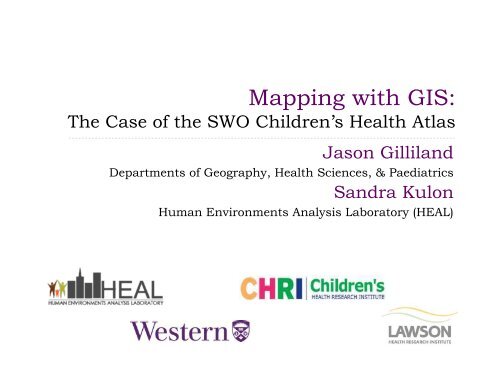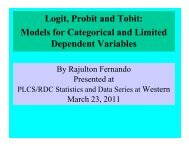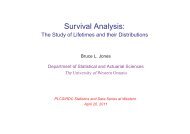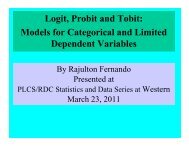Mapping with GIS
Mapping with GIS: - Research Data Centre
Mapping with GIS: - Research Data Centre
- No tags were found...
Create successful ePaper yourself
Turn your PDF publications into a flip-book with our unique Google optimized e-Paper software.
<strong>Mapping</strong> <strong>with</strong> <strong>GIS</strong>:<br />
The Case of the SWO Children’s Health Atlas<br />
Jason Gilliland<br />
Departments of Geography, Health Sciences, & Paediatrics<br />
Sandra Kulon<br />
Human Environments Analysis Laboratory (HEAL)
Discussion Overview<br />
What is <strong>GIS</strong>?<br />
How does it Work<br />
Key Concepts<br />
Building a <strong>GIS</strong><br />
People/Data/Software/Hardware<br />
<strong>GIS</strong> Case Study: Putting Children on the Map<br />
The benefits of <strong>GIS</strong> in Children’s Health Research
What is <strong>GIS</strong>?: Formal Definition<br />
<br />
<br />
Geographic Information System (<strong>GIS</strong>)<br />
A computer based system to aid in the collection, maintenance, storage, analysis,<br />
output and distribution of spatial data and information.<br />
Bolstad (2012)
What is <strong>GIS</strong>?<br />
A Database attached to map<br />
Average Income<br />
In Dollars<br />
< 45,000<br />
45,000.1 - 65,000<br />
65,000.1 - 85,000<br />
85,000.1 - 100,00<br />
> 100,000
What is <strong>GIS</strong>?<br />
A Database attached to map<br />
Unemployment Rate<br />
< 2<br />
2.1 - 5.0<br />
5.1 - 10.0<br />
10.1 - 15.0<br />
15.1 - 28.1
What is <strong>GIS</strong>?<br />
Allows us to dynamically map various attributes from a<br />
table.<br />
Senior Citizens<br />
% of Population<br />
< 2<br />
2.1 - 5.0<br />
5.1 - 8.0<br />
8.1 - 10.0<br />
< 10
Building a <strong>GIS</strong><br />
Components of a <strong>GIS</strong><br />
People<br />
Data<br />
Hardware<br />
Software
Components of <strong>GIS</strong>: People<br />
Understand how geographic data is<br />
to be compiled and managed<br />
Decide how data is to be collected<br />
Make the analysis decisions<br />
Provide the comprehensive and<br />
interpretative component
Components of <strong>GIS</strong>: Data<br />
The Power of <strong>GIS</strong> lies in constructing various data layers<br />
that help model your study area
Components of <strong>GIS</strong>: Data<br />
Data is obtained from several different sources<br />
<br />
<br />
<br />
<br />
Geomatics Organizations<br />
DMTI, First Base Solutions, NTDB<br />
GPS<br />
Collecting your own data<br />
Remote Sensing<br />
Extracting land information from Satellite Imagery<br />
Digitizing<br />
Using existing paper maps and making them digital<br />
Accuracy of Data determines how powerful of a tool your <strong>GIS</strong><br />
is<br />
<br />
Garbage in: Garbage Out<br />
Often, more than 2/3 of the time to complete a <strong>GIS</strong> project<br />
is spent on data preparation!
<strong>GIS</strong> in:<br />
Human Environments Analysis Laboratory<br />
Multi-Disciplinary Research Lab that uses <strong>GIS</strong> to:<br />
Study relationships among environmental, economic, and<br />
social factors, <strong>with</strong> the overall goal to:<br />
identify effects of environmental factors (social and physical) on<br />
population health and quality of life;<br />
offer comprehensive solutions and support work of<br />
municipalities, health units and non-profits;<br />
improve planning and design of communities, to promote<br />
health and quality of life for all.
Case Study:<br />
A Children’s Health Atlas for SWOntario
Context:
Context:
People:
People:
People:
People:
People:
People: The Social Environment
Places: The Physical Environment
Patterns: Linking Environment & Health
Linking Foodscapes to Diet, Obesity & Health<br />
• Obesity linked to diet of ‘fast’<br />
foods 1<br />
• High density of fast-food outlets<br />
linked to unhealthy diet, obesity,<br />
& related diseases 2<br />
• Fast-food more prevalent in<br />
poor neighbourhoods &<br />
supermarkets more scarce 3<br />
1<br />
Ebbeling et al, 2002; Zive et al, 2002; Bowman et al, 2004; 2 Alter & Eny 2005; He et al, 2010;<br />
3<br />
Reidpath et al, 2002; Block et al, 2004; Austin et al, 2005; Larsen & Gilliland 2008
<strong>Mapping</strong> Evolution of a “Food Desert”<br />
Neighbourhoods <strong>with</strong> poor access:<br />
• households pay more for healthy food<br />
• higher levels of food insecurity<br />
• adults poorer diets, poorer health<br />
(evidence NA for children)<br />
Larsen & Gilliland 2008; 2009
Junk Food & Children’s Environments<br />
London, Ontario<br />
Junk food proximity:<br />
• mean distance = 400m<br />
Gilliland 2010; He et al 2011ab; Gilliland et al 2012
Junk Food & Children’s Environments<br />
London, Ontario<br />
Junk food density:<br />
• highest around low SES schools<br />
• influences purchasing,<br />
consumption & BMI<br />
Gilliland 2010; He et al 2011ab; Gilliland et al 2012
Physical Activity & Public Recreation Spaces<br />
• Access to public parks & rec<br />
facilities linked to ↑ PA &<br />
↓obesity , especially for youth 1<br />
• Parks are typically of poorer<br />
quality in low-income areas 2 and<br />
poor quality parks are rarely<br />
used 3<br />
• Walking leads to ↑ PA ↑ health, 4<br />
walking/biking influenced by<br />
environmental factors 5<br />
1<br />
CLFI 2009; Tucker et al, 2008; Huston et al., 2006; 2 Wolch et al. 2005; Coen & Ross, 2005;<br />
3<br />
Gilliland et al 2010; 4 Sesso et al, 1999; Lacroix et al, 1995; Oja et al, 1998; 5 Larsen et al 2009
Access to Public Recreation Spaces
Public park accessibility, quality and use<br />
N=235<br />
School survey:<br />
• Greater access to<br />
public rec opps linked<br />
to more time spent on<br />
MVPA & lower BMI<br />
Park Quality Index:<br />
• playground facilities<br />
• sporting facilities<br />
• comfort facilities<br />
• aesthetics<br />
Play Space<br />
Needs Index:<br />
Play Space Needs Level<br />
• household income<br />
• lone-parenthood<br />
• household crowding<br />
• dwelling type mix<br />
• youth density<br />
Gilliland et al 2006; Gilliland et al 2008; Tucker et al 2009; Gilliland et al 2012
Environmental Influences on Walking to School<br />
Environmental indicators:<br />
Distance between home & school<br />
Land use mix<br />
Density of street trees<br />
Intersection density (‘connectivity’)<br />
Number major streets crossed<br />
Traffic volume<br />
Retail density<br />
Residential density<br />
Dwelling type mix<br />
Number railroads crossed<br />
Sidewalk coverage<br />
Pathway coverage<br />
Streetlight coverage<br />
Route directness<br />
Crime along route<br />
Larsen et al 2009, 2012
Environmental Influences on Walking to School<br />
Environmental indicators:<br />
Distance between home & school<br />
Land use mix<br />
Density of street trees<br />
Intersection density (‘connectivity’)<br />
Number major streets crossed<br />
Traffic volume<br />
Retail density<br />
Residential density<br />
Dwelling type mix<br />
Number railroads crossed<br />
Sidewalk coverage<br />
Pathway coverage<br />
Streetlight coverage<br />
Route directness<br />
Crime along route<br />
Larsen et al 2009, 2012
Benefits of <strong>GIS</strong><br />
• Ability to manage and manipulate many massive datasets!
Benefits of <strong>GIS</strong><br />
• Quickly raise and test hypotheses, and to uncover<br />
relationships which would otherwise be indiscernible!
Benefits of <strong>GIS</strong><br />
• Powerful analytical tools to discover, quantify, and<br />
visualize spatial patterns!<br />
E.g. ‘Model Builder’ helps us manipulate<br />
large datasets and re-test hypotheses<br />
E.g. ‘KDE’ one way to measure<br />
and visualize density of spatial<br />
phenomena
Recommendations<br />
• <strong>GIS</strong> is fundamental for research and decision-making…<br />
• Always carefully plan a project …<br />
• Know your data limitations …<br />
• Know your geography … hire a geographer!
Thank you…<br />
For further info on <strong>GIS</strong> at Western:<br />
• Geography Dept: <strong>GIS</strong> courses (www.uwo.ca/geog)<br />
• Equinox: <strong>GIS</strong> data (http://equinox.uwo.ca)<br />
• Map and Data Centre: (http://www.lib.uwo.ca/madgic)<br />
• Human Environments Analysis Lab: (www.spatialists.com)<br />
• Dr Jason Gilliland: advice (urbanprof@gmail.com)









